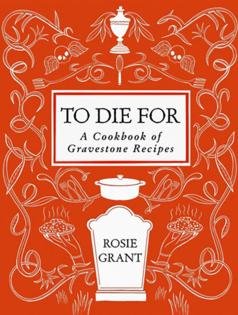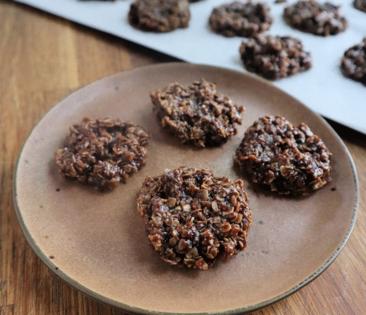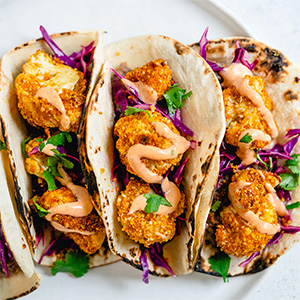'To Die For' cookbook features family recipes etched onto gravestones
Published in Variety Menu
Most everyone has a favorite recipe, and it's often something your mother, grandmother or another beloved relative made over the years for family dinners or holiday get-togethers
It could be something as simple as a cookie recipe clipped from a newspaper or a cherished ravioli recipe that's been handed down over the generations and copied by hand into family cookbooks for posterity.
What they have in common are the memories the food evokes and comfort and sense of belonging it brings when it's re-created.
Bonnie June Rainey Johnson's family thought of another way to make her legendary no-bake chocolate oatmeal cookies live forever: After she died in 2007, they had the cookie recipe etched onto her headstone at Nome City Cemetery in Alaska, along with an image of the Cool Whip container the thrifty cook and single mother famously stored them in.
"All the ingredients are shelf stable because everything has to be shipped in [when you live in Alaska]," notes Rosie Grant, who included the recipe, with 39 others pulled from tombstones across the U.S., in her just-released cookbook, "To Die For: A Cookbook of Gravestone Recipes" (Harvest, $26).
The stone obelisk also includes two poems written by Johnson's granddaughter, a carving of her favorite flower (an iris) and an airplane to commemorate her days as a flight attendant.
Johnson's drop cookies, which were beloved by not only her family but people who ate them at bake sales and other community functions, demonstrate how resourceful Alaskans must be on a daily basis "because you can't waste food" when your pantry is limited, Grant says.
Some might find this cookbook weird or morbid. But to Grant, a Los Angeles-based librarian and archivist who created the viral recipe platform Ghostly Archive on TikTok and Instagram in 2021, it makes sweet sense.
"So many people remember someone they lost through food," she said on a recent phone interview from her hometown of Alexandria, Va., where her parents — both retired government workers — work as ghost guides in historic Old Town.
"For me and for others, it was just like, 'Wait, you can do that?'"
Though people have been etching parting phrases or philosophical quotes into family members' tombstones for centuries, including recipes along with the loved one's name and dates of birth and death is still a relatively new phenomenon, if you don't count The Tomb of Eurysaces the Baker in Rome, which includes elaborate friezes depicting the process of bread-making.
According to the travel company Atlas Obscura, the oldest known examples of gravestone recipes date to the 1990s. That would include "Mom's Christmas Cookies," which the family of Maxine Menster had etched onto her tombstone in Iowa as a remembrance after she passed in 1994. (It's in Grant's book.)
Grant, whose favorite holiday since childhood has always been Halloween, says the idea for the cookbook grew out of a project she did in graduate school at Congressional Cemetery in Washington, D.C.
After earning a degree in English and creative writing from James Madison University in 2012, Grant worked as a writer and ESL teacher in Asia before getting a job in digital communications with the National Building Museum in downtown D.C. A favorite part of her job was going into the archives so see how staffers were working to make the museum's collections more accessible for visitors.
She found archival work so fascinating and important that in 2020 she enrolled in graduate school at the University of Maryland to get a master's degree in library and information science.
During an internship at the cemetery, Grant was tasked with creating a digital footprint of the gravestones to make an online portal for tours and storytelling. At the same time, she was taking a class about how social media algorithms work, and was assigned to create a social media account.
Her professor gave her an idea when he asked: What's it like to intern at a cemetery?
"So I started posting daily about what I was learning," including little-known facts about cemeteries along with pictures and videos about famous residents and interesting gravestones through the TikTok account @ghostlyarchive.
During her research, Grant stumbled upon Naomi Odessa Miller-Dawson's gravestone in Green-Wood Cemetery in Brooklyn, N.Y. Fashioned like an open book, it includes the ingredients for Dawson's spritz cookie recipe.
"And I thought: What do they taste like?" Grant said. So she decided to make them and post about it, despite the fact she wasn't a baker.
"There's no instructions so I'm guessing a lot. If a sugar cookie and a shortbread cookie had a baby, they're to die for," she reported in a 2022 video that went viral almost overnight with 1.3 million views.
Many of the responses were from people who had never heard of gravestone recipes and thought it was cool. Grant also received lots of stories about how people remember someone they lost through food.
Naomi's spritz cookie recipe led to a Google search for more gravestone recipes, turning up "Kay's Fudge" in Utah, "Mom's Christmas Cookies" in Iowa and Johnson's "Chocolate Oatmeal Cookies (No Bake)" in Alaska.
"I did three recipes in a row and thought, 'That's cool,' and then there were 10 and then 20, and I thought, 'Is this a thing?"
The archivist in her decided it was and soon she also interviewing families, turning it into an oral history project.
"It was important to see how they felt about it," she said. "What was food to them, and what does it mean to taste it now after [the loved one] passed away. I was getting these little food histories, transcribing it, doing summaries and then sending it back to the families to make sure I had the right details."
By the time she had collected about 30 recipes, a few editors were reaching out, thinking it could be a cookbook instead of a community archive if she came up with the standard 100 recipes.
Grant didn't want that. Instead, she partnered with an editor at Harvest who agreed this wouldn't be a typical cookbook but instead one that asks: Who is this person and why did they do this?
Grant visited all 40 of the graves included in the book both to document them and learn more about the baker or cook from their families. About half of the recipes were chosen by the deceased and the other half by those left behind; all share the stories behind the bakers and what made them and their recipe so special.
Not surprisingly, some family members were hesitant to talk to her at first because they were still grieving, "and I had to be mindful of that." Other times it was just figuring out how to get connected through a second cousin or uncle or daughter by searching obituaries.
"But if I got permission, we were good to go," Grant said.
It took her more than a year, for instance, to arrange a visit and interview with Maxine Menster's daughter, Jane, to talk about "Mom's Christmas Cookies," which the Iowa baker hung on the family tree the night before Christmas as a symbol of gathering and family tradition.
Some of the trips ended with Grant cooking with a daughter or granddaughter or visiting a local diner that was important to the deceased to get a better sense of the person. Traveling thousands of miles to cities as disparate as Ottawa, Salt Lake City, Nome and Truro, Nova Scotia, was a little easier once she got the book deal because she could finance the trips with her advance.
The experience of researching and writing the cookbook, she said, "is the most meaningful and wonderful thing I've ever done."
The cookbook divides the recipes into six categories, and includes a helpful glossary of cemetery and end-of-life terms. Most are for sweet treats like brownies, cookies, cakes, pies and fudge, but there's also a handful of savory recipes.
One came from this epitaph engraved on Beverly Lofland's headstone in Texas after her passing in 2006: "She made the best meatloaf."
Because Grant hopes the cookbook will inspire others to talk to their own families about their shared family food history, she offers 21 questions to help readers document it, along with tips on archiving them through recordings, transcripts and photos.
Grant now lives in Los Angeles and works for UCLA's Center for the Study of Women as an outreach and communications director. She's also a newlywed whose proposal from her husband, James Jelin, came in the form of — you guessed it — a gravestone recipe.
She was traipsing through a pet cemetery on Santa Catalina Island, Calif., when he popped the question with a zinc tombstone engraved with a "recipe for love."
"Enjoy forever," the last line reads.
Texas Sheet Cake
PG tested
This decadent sheet cake is so easy that Rosie Grant says she makes it for every special occasion. It is etched onto Helen Rose Sweers' headstone in Cutlerville, Mich. "It's a symbol of Helen's warmth, generosity and her knack for turning simple ingredients into something extraordinary," Grant writes in the cookbook "To Die For."
For cake
1 cup (2 sticks) butter
3 tablespoons unsweetened cocoa powder
2 cups granulated sugar
2 eggs
1/2 cup sour milk or buttermilk
2 cups all-purpose flour, sifted
1 teaspoon baking soda
1 teaspoon baking powder
1/2 teaspoon salt
For frosting
1/2 cup (1 stick) butter, melted
1/3 cup milk
2 tablespoons unsweetened cocoa powder
1 teaspoon vanilla extract
4 cups confectioners' sugar
1 cup chopped walnuts
Make cake: Preheat oven to 350 degrees. Grease a 10 1/2 -by-15 1/2 -inch jelly roll pan and set aside.
In a saucepan, combine butter, 1 cup water and cocoa, and bring to a boil over medium heat, stirring occasionally, until the butter has melted. Remove from heat and set aside.
In large bowl, whisk together granulated sugar, eggs and sour milk.
Add flour, baking soda, baking powder and salt. Mix until combined, then pour in the melted butter mixture. Mix well until combined.
Pour the batter into the prepared jelly roll pan. Bake for about 15 minutes.
Meanwhile, make the frosting. In a large bowl, combine melted butter, milk, cocoa and vanilla, mixing until combined.
Add confectioners' sugar and stir to combine.
Pour the frosting directly onto the hot cake and spread. Garnish with the chopped walnuts.
Makes 1 cake.
No-Bake Chocolate Oatmeal Cookies
PG tested
This recipe shows the ingenuity of Alaskans, who have to rely on simple, shelf-stable ingredients for baking. You might be tempted to substitute butter in this no-bake cookie. But its creator, Bonnie June Rainey Johnson, said the cookies set more easily with margarine.
2 cups sugar
1/2 cup whole milk
1/4 cup cocoa or 1 Swiss Miss packet
1/4 cup margarine
2 tablespoons creamy peanut butter, preferably Skippy
2 teaspoons vanilla extract
3 cups quick oats
Line a baking sheet with parchment or waxed paper. Set aside.
In medium saucepan, combine sugar, milk, cocoa powder and margarine.
Place the saucepan over medium heat, stirring frequently, until the margarine is melted and the ingredients are combined.
Bring the mixture to a rolling boil where the bubbles don't disappear when stirred. Allow it to boil for 1 minute, stirring constantly to prevent burning.
After 1 minute, remove saucepan from the heat. Quickly stir in the peanut butter and vanilla until melted and well combined.
Add quick oats and stir until oats are fully coated in the chocolate mixture.
Using a spoon, drop spoonfuls of the mixture on a prepared baking sheet. Flatten each portion slightly to create cookie shapes.
Allow the cookies to cool and set at room temperature for about 30 minutes, or until firm. Once set, enjoy them right away.
Store any leftovers in an airtight container at room temperature for up to 1 week.
— Bonnie June Rainey Johnson
Best Meatloaf
PG tested
Beverly Lofland's headstone in New Braunfels, Texas, pays homage to her expertise with just five words: "She made the best meatloaf." Her son, John Collins, contributed the actual recipe to Comal Cemetery's cookbook, "Recipes for the Soul: A Book of Funeral Food, Tips, and Stories."
3/4 cup milk
2 eggs
1/3 cup ketchup
1 packet dry onion soup mix
1 tablespoon Worcestershire sauce
1 teaspoon salt
1/2 teaspoon pepper
5 slices white sandwich bread, cut into cubes
2 pounds lean ground beef
2 slices partially cooked bacon, for on top
Preheat oven to 350 degrees.
In large bowl, combine milk, eggs, ketchup, onion soup mix, Worcestershire sauce, salt and pepper.
Add bread and beef and mix well with your hands.
Press the meat into a 9-by-5-inch loaf pan. Layer the bacon on top of the meatloaf.
Bake for 1 hour 15 minutes, until the meat is done. Let cool for 10 minutes.
Makes 1 meatloaf.
— Beverly Lofland
©2025 PG Publishing Co. Visit at post-gazette.com. Distributed by Tribune Content Agency, LLC.















Comments